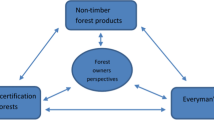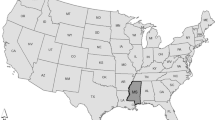Abstract
Forest certification is a global voluntary, market-based approach to promoting sustainable forest management. A major barrier for small landowners like nonindustrial private forest (NIPF) landowners in the southeastern United States to participate in this program is certification costs. We conducted a mail survey of NIPF landowners in Arkansas to uncover whether they are willing to pay for forest certification and factors that influence their willingness to pay. Most of these landowners were not familiar with (68.7%) nor interested in (51.4%) forest certification. Younger or well-educated landowners and those with a higher household income, having a desire to protect nature and biodiversity and wildlife, or having received information or professional advice about forest management were more likely to pay for the certification. A clear picture also emerged of how these landowners desired to be educated about certification via both active and passive education methods. Our findings indicate that there is limited potential for expanding the participation of the NIPF landowners in the existing forest certification programs. A large-scale expansion, however, would require forest certification programs to effectively address the certification cost barrier and to incentivize those who desire to protect nature and biodiversity as well as privacy.

Similar content being viewed by others
References
Bell CD, Roberts RK, English BC, Park WM (1994) A logit analysis of participation in Tennessee’s forest stewardship program. J Agric Appl Econ 26:463–472
Bensel T (2001) Promoting certified sustainable forestry on private woodlots in north-western Pennsylvania: Challenges and opportunities. Local Environ 6:257–278
Butler BJ, Butler SM, Caputo J, Dias J, Robillard A, Sass EM (2020) Family forest ownerships of the United States, 2018: results from the USDA Forest Service, National Woodland Owner Survey. Gen. Tech. Rep. NRS-199. Madison, WI: U.S. Department of Agriculture, Forest Service, Northern Research Station. 52 p. [plus 4 appendixes] https://doi.org/10.2737/NRSGTR-199
Butler BJ, Leatherberry EC (2004) America’s family forest owners. J For 102:4–14
Cai Z, Aguilar FX (2013) Meta-analysis of consumer’s willingness-to-pay premiums for certified wood products. J of For Econ 19(1):15–31. https://doi.org/10.1016/j.jfe.2012.06.007
Chen J, Innes JL (2013) The implications of new forest tenure reforms and forestry property markets for sustainable forest management and forest certification in China. J Environ Manag 129:206–215
Dillman DA (2000) Mail and Internet Surveys: The Tailored Design Method, 2nd edn. John Wiley & Sons, New York, NY, USA, p 464
Fernholz K, Bowyer J, Erickson G, Groot H, Jacobs M, McFarland A, Pepke E (2021) Forest Certification Update 2021: The Pace of Change. Dovetail Partners. Accessed on June 9, 2021, https://dovetailinc.org/upload/tmp/1611160123.pdf
Hayward J, Vertinsky I (1999) High expectations, unexpected benefits: What managers and owners think of certification. J For 97:13–17
He M, Wu Z, Li W, Zeng Y (2015) Forest certification in collectively owned forest areas and sustainable forest management: A case of cooperative-based forest certification in China. Small Scale For 14:245–254
Kilgore MA, Leahy JE, Hibbard CM, Donnay JS (2007) Assessing family forestland certification opportunities: A Minnesota case study. J For 105:27–33
Kline J, Alig RJ, Johnson RL (2000) Fostering the production of nontimber services among forest owners with heterogeneous objectives. For Sci 46:302–311
Knoot TG, Rickenbach M, Silbernagel K (2015) Payments for ecosystem services: Will a new hook net more active family forest owners? J For 113:210–218
Leahy JE, Kilgore MA, Hibbard CM, Donnay JS (2008) Family forest landowners’ interest in and perceptions of forest certification: Focus group findings from Minnesota. North J Appl For 25:73–81
Ma Z, Butler BJ, Kittredge DB, Catanzaro P (2012) Factors associated with landowner involvement in forest conservation programs in the U.S.: Implications for policy design and outreach. Land Use Policy 29:53–61
Nagubadi V, McNamara KT, Hoover WL, Mills WL (1996) Program participation behavior of nonindustrial forest landowners: A probit analysis. J Agric Appl Econ 28:323–336
Natural Resources Canada (2020) Forest land ownership. Accessed on June 9, 2021, https://www.nrcan.gc.ca/our-natural-resources/forests-forestry/sustainable-forest-management/forest-land-ownership/17495
Newsom D, Cashore B, Auld G, Granskog JE (2003) Forest certification in the heart of Dixie: A survey of Alabama landowners. In: Cashore B, Zhangh D (eds) Forest Policy for Private Forestry: Global and Regional Challenges, Teeter, L. CAB International, pp 291–300
Oswalt SN, Smith WB, Miles PD, Pugh SA (2019) Tech. Rep. WO-97. U.S. Department of Agriculture, Forest Service, Washington Office, Washington, DC, p 223. https://doi.org/10.2737/WO-GTR-97. Forest Resources of the United States, 2017: a technical document supporting the Forest Service 2020 RPA Assessment. Gen
Perera P, Vlosky RP, Hughes G, Dunn MA (2007) What do Louisiana and Mississippi nonindustrial private forest landowners think about forest certification? South J Appl For 31:170–175
Rickenbach MG (2002) Forest certification of small ownerships: Some practical challenges. J For 100:43–47
State and Private Forestry Fact Sheet, Arkansas (2021) Accessed on June 18, 2021, https://apps.fs.usda.gov/nicportal/temppdf/sfs/naweb/AR_std.pdf
Sun X, Sun C, Munn IA, Hussain A (2009) Knowledge of three regeneration programs and application behavior among Mississippi nonindustrial private forest landowners: A two-step sample selection approach. J For Econ 15(3):187–204
Tian N, Poudyal NC, Lu F (2018a) Understanding Landowners’ interest and willingness to participate in forest certification program in China. Land Use Policy 71:271–280
Tian N, Poudyal NC, Lu F (2021) Assessments of Landowners’ Willingness to Accept Compensation for Participating in Forest Certification in Shandong, China. Sustainability 13:903. https://doi.org/10.3390/su13020903
Tian N, Lu F, Joshi O, Poudyal NC (2018b) Segmenting Landowners of Shandong, China Based on Their Attitudes towards Forest Certification. Forests 9:361. doi:https://doi.org/10.3390/f9060361
Tian N, Poudyal NC, Hodges DG, Young TM, Hoyt KP (2015) Understanding the Factors Influencing Nonindustrial Private Forest Landowner Interest in Supplying Ecosystem Services in Cumberland Plateau. Tenn Forests 6:3985–4000
Tian N, Pelkki M (2021) Opportunities and Interests of Arkansas Nonindustrial Private Forest Landowners in Participating in a Forest Certification Program. For Policy Econ 131:102–552
U.S. Endowment for Forestry and Communities (2020) The State of America’s Forests. Accessed on June 9, 2021, https://usaforests.org/
USDA Forest Service (2021) Family forest (10 + acres) ownership characteristics: Arkansas, 2018. Res. Note NRS-266. Madison, WI: U.S. Department of Agriculture, Forest Service, Northern Research Station. 2 p. https://doi.org/10.2737/NRS-RN-266
Van Herzele A, van Gossum P (2009) Owner-specific factors associated with conversion activity in secondary pine plantations. For Policy Econ 11:230–236
Vlosky RP (2000) Certification: Perceptions of non-industrial private forestland owners in Louisiana. Working Paper 41, Louisiana Forest Products Laboratory, Louisiana State University Agricultural Center, Baton Rouge, LA. 12 p
Wear DN, Greis JG (2013) The Southern Forest Futures Project: technical report. Gen. Tech. Rep. SRS-GTR-178. Asheville, NC: USDA-Forest Service, Southern Research Station. 542 p
Zhao J, Xie D, Wang D, Deng H (2011) Current status and problems in certification of sustainable forest management in China. Environ Manag 48:1086–1094
Acknowledgements
We are thankful for the support provided by the College of Forestry, Agriculture & Natural Resources and the Arkansas Center for Forest Business at the University of Arkansas at Monticello in completing this study.
Funding
This research did not receive any specific grant from funding agencies in the public, commercial, or not-for-profit sectors.
Author information
Authors and Affiliations
Corresponding author
Ethics declarations
Conflict of interest
The authors declare no conflict of interest.
Additional information
Publisher’s Note
Springer Nature remains neutral with regard to jurisdictional claims in published maps and institutional affiliations.
Rights and permissions
About this article
Cite this article
Tian, N. Nonindustrial Private Forest Landowners (NIPF) Willingness to Pay for Forest Certification in Arkansas. Small-scale Forestry 21, 681–695 (2022). https://doi.org/10.1007/s11842-022-09507-x
Received:
Revised:
Accepted:
Published:
Issue Date:
DOI: https://doi.org/10.1007/s11842-022-09507-x




